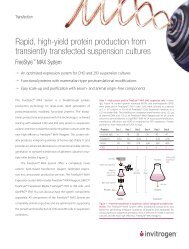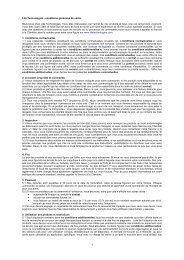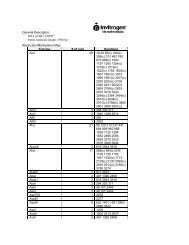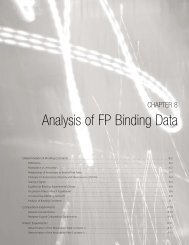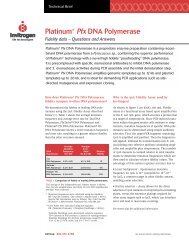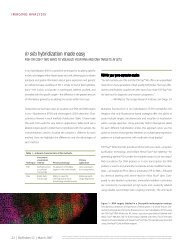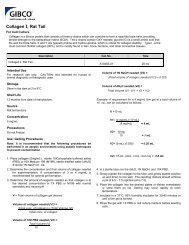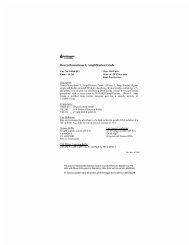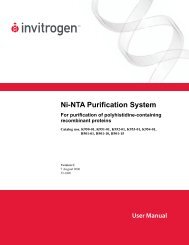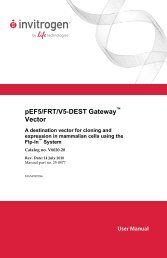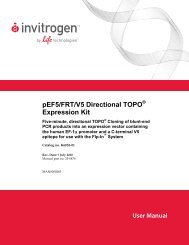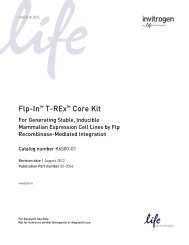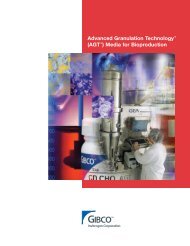pcDNA 5/FRT/TO - Invitrogen
pcDNA 5/FRT/TO - Invitrogen
pcDNA 5/FRT/TO - Invitrogen
Create successful ePaper yourself
Turn your PDF publications into a flip-book with our unique Google optimized e-Paper software.
<strong>pcDNA</strong> 5/<strong>FRT</strong>/<strong>TO</strong><br />
Inducible expression vector designed for<br />
use with the Flp-In T-REx System<br />
Cat. no. V6520-20<br />
Version G<br />
11 November 2010<br />
25-0368<br />
User Manual
Table of Contents<br />
Kit Contents and Storage ............................................................................................. v<br />
Methods ......................................................................................................................... 1<br />
Overview.................................................................................................................................................................1<br />
Cloning into <strong>pcDNA</strong> 5/<strong>FRT</strong>/<strong>TO</strong> .......................................................................................................................4<br />
Transfection ............................................................................................................................................................7<br />
Appendix........................................................................................................................ 9<br />
<strong>pcDNA</strong> 5/<strong>FRT</strong>/<strong>TO</strong> Vector..................................................................................................................................9<br />
<strong>pcDNA</strong> 5/<strong>FRT</strong>/<strong>TO</strong>/CAT Vector .....................................................................................................................11<br />
Technical Support ................................................................................................................................................12<br />
Purchaser Notification ........................................................................................................................................13<br />
References .............................................................................................................................................................16<br />
iii
Kit Contents and Storage<br />
Contents 20 μg of <strong>pcDNA</strong> 5/<strong>FRT</strong>/<strong>TO</strong> in TE buffer, pH 8.0 (40 μl at 0.5 μg/μl)<br />
20 μg of <strong>pcDNA</strong> 5/<strong>FRT</strong>/<strong>TO</strong>/CAT in TE buffer, pH 8.0 (40 μl at 0.5 μg/μl)<br />
TE Buffer: 10 mM Tris-HCl, 1 mM EDTA, pH 8.0<br />
Shipping/Storage Plasmids are supplied in TE buffer and shipped on wet ice. They should be<br />
stored at –20°C upon arrival.<br />
Accessory<br />
Products<br />
Many of the reagents used in the Flp-In T-REx System are available separately<br />
from <strong>Invitrogen</strong>. See the table below for ordering information.<br />
Item Amount Cat. no.<br />
Zeocin 1 g R250-01<br />
5 g R250-05<br />
p<strong>FRT</strong>/lacZeo 20 μg in TE, pH 8.0<br />
(40 μl at 0.5 μg/μl)<br />
V6015-20<br />
p<strong>FRT</strong>/lacZeo2 20 μg in TE, pH 8.0<br />
(40 μl at 0.5 μg/μl)<br />
V6022-20<br />
<strong>pcDNA</strong>6/TR 20 μg in TE, pH 8.0<br />
(40 μl at 0.5 μg/μl)<br />
V1025-20<br />
pOG44 20 μg in TE, pH 8.0<br />
(40 μl at 0.5 μg/μl)<br />
V6005-20<br />
PureLink HQ Plasmid Miniprep Kit 100 reactions K2100-01<br />
continued on next page<br />
v
Kit Contents and Storage, continued<br />
Other Flp-In <br />
T-REX Products<br />
Flp-In Host Cell<br />
Lines<br />
vi<br />
A number of other Flp-In T-REx products are available from <strong>Invitrogen</strong> to<br />
facilitate expression of your gene of interest in the Flp-In T-REx System.<br />
The Flp-In T-REx Core Kit contains vectors (p<strong>FRT</strong>/lacZeo, <strong>pcDNA</strong> 6/TR,<br />
<strong>pcDNA</strong> 5/<strong>FRT</strong>/<strong>TO</strong>, and pOG44), primers, and tetracycline.<br />
The <strong>pcDNA</strong> 5/<strong>FRT</strong>/<strong>TO</strong> <strong>TO</strong>PO ® TA Expression Kit allows rapid and efficient<br />
<strong>TO</strong>PO ® Cloning of Taq-amplified PCR products into the <strong>pcDNA</strong> 5/<strong>FRT</strong>/<strong>TO</strong>-<br />
<strong>TO</strong>PO © vector. The Flp-In T-REx -293 Cell Line contains a single integrated <strong>FRT</strong><br />
site and stably expresses the Tet repressor, and allows the user to proceed directly<br />
to generation of the Flp-In T-REx expression cell line.<br />
For more information about these products go to www.invitrogen.com or contact<br />
Technical Support (see page 12).<br />
Cell Line Amount Cat. no.<br />
Flp-In T-REx Core Kit 1 kit K6500-01<br />
<strong>pcDNA</strong> 5/<strong>FRT</strong>/<strong>TO</strong><br />
<strong>TO</strong>PO ® TA Expression Kit<br />
20 reactions K6510-20<br />
Flp-In T-REx -293 3 × 10 6 cells, frozen R780-07<br />
For your convenience, <strong>Invitrogen</strong> has available several mammalian Flp-In host<br />
cell lines that stably express the lacZ-Zeocin fusion gene from p<strong>FRT</strong>/lacZeo or<br />
p<strong>FRT</strong>/lacZeo2 (Flp-In -CHO). Each cell line contains a single integrated <strong>FRT</strong> site<br />
as confirmed by Southern blot analysis. By transfecting the <strong>pcDNA</strong> 6/TR<br />
plasmid into these cell lines, you can easily generate Flp-In T-REx host cell<br />
lines.<br />
For more information go to www.invitrogen.com or contact Technical Support<br />
(see page 12).<br />
Cell Line Amount Cat. no.<br />
Flp-In-293 3 × 106 cells, frozen R750-07<br />
Flp-In -CV-1 3 × 10 6 cells, frozen R752-07<br />
Flp-In -CHO 3 × 10 6 cells, frozen R758-07
Overview<br />
Methods<br />
Introduction <strong>pcDNA</strong>5/<strong>FRT</strong>/<strong>TO</strong> is a 5.1 kb inducible expression vector designed for use with<br />
the Flp-In T-REx System (Cat. no. K6500-01) available from <strong>Invitrogen</strong>. When<br />
cotransfected with the pOG44 Flp recombinase expression plasmid into a Flp-In T-REx mammalian host cell line, the <strong>pcDNA</strong>5/<strong>FRT</strong>/<strong>TO</strong> vector containing the<br />
gene of interest is integrated in a Flp recombinase-dependent manner into the<br />
genome. Expression of the gene of interest may be induced by the addition of<br />
tetracycline to the culture medium. The vector contains the following elements:<br />
• A hybrid human cytomegalovirus (CMV)/TetO2 promoter for high-level,<br />
tetracycline-regulated expression of the gene of interest in a wide range of<br />
mammalian cells (Andersson et al., 1989; Boshart et al., 1985; Hillen and Berens,<br />
1994; Hillen et al., 1983; Nelson et al., 1987)<br />
• Multiple cloning site with 10 unique restriction sites to facilitate cloning the<br />
gene of interest<br />
• FLP Recombination Target (<strong>FRT</strong>) site for Flp recombinase-mediated integration<br />
of the vector into the Flp-In T-REx host cell line (see page 2 for more<br />
information)<br />
• Hygromycin resistance gene for selection of stable cell lines (Gritz and Davies,<br />
1983)<br />
The control plasmid, <strong>pcDNA</strong>5/<strong>FRT</strong>/<strong>TO</strong>/CAT, is included for use as a positive<br />
control for transfection and expression in the Flp-In T-REx host cell line of choice.<br />
For more information about the Flp-In T-REx System, the pOG44 plasmid, and<br />
generation of the Flp-In T-REx host cell line, refer to the Flp-In T-REx Core Kit<br />
manual. The Flp-In T-REx Core Kit manual is supplied with the Flp-In T-REx Core Kit, but is also available from www.invitrogen.com or by contacting Technical<br />
Support (see page 12).<br />
Hybrid CMV/TetO2<br />
Promoter<br />
Expression of your gene of interest from <strong>pcDNA</strong>5/<strong>FRT</strong>/<strong>TO</strong> is controlled by the<br />
strong CMV immediate early enhancer/promoter (Andersson et al., 1989; Boshart<br />
et al., 1985; Nelson et al., 1987) into which 2 copies of the tet operator 2 (TetO2)<br />
sequence have been inserted in tandem. Insertion of these TetO2 sequences into the<br />
CMV promoter confers regulation by tetracycline to the promoter.<br />
The TetO2 sequences consist of 2 copies of the 19 nucleotide sequence,<br />
5´-TCCCTATCAGTGATAGAGA-3´ separated by a 2 base pair spacer (Hillen and<br />
Berens, 1994; Hillen et al., 1983). Each 19 nucleotide TetO2 sequence serves as the<br />
binding site for 2 molecules of the Tet repressor. For more information about the<br />
mechanism of tetracycline regulation in the Flp-In T-REx System, refer to the<br />
Flp-In T-REx Core Kit manual.<br />
continued on next page<br />
1
Overview, continued<br />
A Note About<br />
<strong>pcDNA</strong> 5/<strong>FRT</strong>/<strong>TO</strong><br />
2<br />
Important<br />
Flp Recombinase-<br />
Mediated DNA<br />
Recombination<br />
The <strong>pcDNA</strong> 5/<strong>FRT</strong>/<strong>TO</strong> vector contains a single <strong>FRT</strong> site immediately upstream<br />
of the hygromycin resistance gene for Flp recombinase-mediated integration and<br />
selection of the <strong>pcDNA</strong> 5/<strong>FRT</strong>/<strong>TO</strong> plasmid following cotransfection of the<br />
vector (with pOG44) into Flp-In T-REx mammalian host cells. The <strong>FRT</strong> site<br />
serves as both the recognition and cleavage site for the Flp recombinase and<br />
allows recombination to occur immediately adjacent to the hygromycin resistance<br />
gene. The Flp recombinase is expressed from the pOG44 plasmid. For more<br />
information about the <strong>FRT</strong> site and recombination, see the next page. For more<br />
information about pOG44, refer to the Flp-In T-REx Core Kit manual.<br />
The hygromycin resistance gene in <strong>pcDNA</strong> 5/<strong>FRT</strong>/<strong>TO</strong> lacks a promoter and an<br />
ATG initiation codon; therefore, transfection of the <strong>pcDNA</strong> 5/<strong>FRT</strong>/<strong>TO</strong> plasmid<br />
alone into mammalian host cells will not confer hygromycin resistance to the cells.<br />
The SV40 promoter and ATG initiation codon required for expression of the<br />
hygromycin resistance gene are integrated into the genome (in the Flp-In T-REx <br />
host cell line) and are only brought into the correct proximity and frame with the<br />
hygromycin resistance gene through Flp recombinase-mediated integration of<br />
<strong>pcDNA</strong> 5/<strong>FRT</strong>/<strong>TO</strong> at the <strong>FRT</strong> site. For more information about the generation of<br />
the Flp-In T-REx host cell line and details of the Flp-In T-REx System, refer to<br />
the Flp-In T-REx Core Kit manual.<br />
In the Flp-In T-REx System, integration of your <strong>pcDNA</strong>5/<strong>FRT</strong>/<strong>TO</strong> inducible<br />
expression construct into the genome occurs via Flp recombinase-mediated<br />
intermolecular DNA recombination. The hallmarks of Flp-mediated recombination<br />
are listed below.<br />
• Recombination occurs between specific <strong>FRT</strong> sites (see below) on the interacting<br />
DNA molecules<br />
• Recombination is conservative and requires no DNA synthesis; the <strong>FRT</strong> sites<br />
are preserved following recombination and there is minimal opportunity for<br />
introduction of mutations at the recombination site<br />
• Strand exchange requires only the small 34 bp minimal <strong>FRT</strong> site (see next<br />
page)<br />
For more information about the Flp recombinase and conservative site-specific<br />
recombination, refer to published reviews (Craig, 1988; Sauer, 1994).<br />
continued on next page
Overview, continued<br />
<strong>FRT</strong> Site The <strong>FRT</strong> site, originally isolated from Saccharomyces cerevisiae, serves as a binding<br />
site for Flp recombinase and has been well-characterized (Gronostajski and<br />
Sadowski, 1985; Jayaram, 1985; Sauer, 1994; Senecoff et al., 1985). The minimal <strong>FRT</strong><br />
site consists of a 34 bp sequence containing two 13 bp imperfect inverted repeats<br />
separated by an 8 bp spacer that includes an Xba I restriction site (see figure<br />
below). An additional 13 bp repeat is found in most <strong>FRT</strong> sites, but is not required<br />
for cleavage (Andrews et al., 1985). While Flp recombinase binds to all three of the<br />
13 bp repeats, strand cleavage actually occurs at the boundaries of the 8 bp spacer<br />
region (see figure below) (Andrews et al., 1985; Senecoff et al., 1985).<br />
Minimal <strong>FRT</strong> site<br />
Experimental<br />
Outline<br />
GAAGTTCCTATTCCGAAGTTCCTATTCTCTAGAAAGTATAGGAACTTC<br />
Xba I<br />
CS = cleavage site<br />
The following table outlines the steps required to clone and inducibly express<br />
your gene of interest in <strong>pcDNA</strong> 5/<strong>FRT</strong>/<strong>TO</strong>.<br />
CS<br />
Step Action<br />
1 Consult the multiple cloning site diagrammed on page 5 to design<br />
your cloning strategy.<br />
2 Ligate your insert into <strong>pcDNA</strong>5/<strong>FRT</strong>/<strong>TO</strong> and transform into E. coli.<br />
Select transformants on 50 to 100 μg/ml ampicillin.<br />
3 Analyze your transformants for the presence of insert by restriction<br />
digestion.<br />
4 Select a transformant with the correct restriction pattern and sequence<br />
to confirm that your gene is cloned in the correct orientation.<br />
5 Cotransfect your <strong>pcDNA</strong>5/<strong>FRT</strong>/<strong>TO</strong> construct and pOG44 into the<br />
Flp-In T-REx host cell line using your own method of choice and<br />
select for hygromycin resistant clones (see the Flp-In T-REx Core<br />
Kit manual for more information).<br />
6 Add tetracycline to induce expression of the gene of interest (see the<br />
Flp-In T-REx Core Kit manual for more information).<br />
7 Assay for expression of the gene of interest.<br />
CS<br />
3
Cloning into <strong>pcDNA</strong> 5/<strong>FRT</strong>/<strong>TO</strong><br />
Introduction A diagram is provided on the next page to help you clone your gene of interest<br />
into <strong>pcDNA</strong> 5/<strong>FRT</strong>/<strong>TO</strong>. General considerations for cloning and transformation<br />
are listed below.<br />
General Molecular<br />
Biology<br />
Techniques<br />
4<br />
For help with DNA ligations, E. coli transformations, restriction enzyme analysis,<br />
DNA sequencing, and DNA biochemistry, refer to Molecular Cloning: A Laboratory<br />
Manual (Sambrook et al., 1989) or Current Protocols in Molecular Biology (Ausubel et<br />
al., 1994).<br />
E. coli Strain Many E. coli strains are suitable for the propagation and maintenance of this<br />
vector. We recommend that you propagate vectors containing inserts in E. coli<br />
strains that are recombination deficient (recA) and endonuclease A deficient<br />
(endA).<br />
For your convenience, <strong>TO</strong>P10 and DH5α-T1R cells are available as chemically<br />
competent or electrocompetent (<strong>TO</strong>P10 only) cells from <strong>Invitrogen</strong>.<br />
Transformation<br />
Method<br />
Maintenance of<br />
Plasmids<br />
Item Quantity Cat. no.<br />
One Shot ® <strong>TO</strong>P10 Chemically Competent Cells 20 reactions C4040-03<br />
One Shot ® <strong>TO</strong>P10 Electrocomp Cells 20 reactions C4040-52<br />
One Shot ® DH5α-T1R Max Efficiency ® Chemically<br />
Competent Cells<br />
20 reactions 12297-016<br />
You may use any method of your choice for transformation. Chemical<br />
transformation is the most convenient method for many researchers.<br />
Electroporation is the most efficient and the method of choice for large plasmids.<br />
To propagate and maintain the <strong>pcDNA</strong> 5/<strong>FRT</strong>/<strong>TO</strong> and <strong>pcDNA</strong> 5/<strong>FRT</strong>/<strong>TO</strong>/CAT<br />
vectors, use 10 ng of each vector to transform a recA, endA E. coli strain like <strong>TO</strong>P10,<br />
DH5α -T1 R , JM109, or equivalent. Select transformants on LB agar plates<br />
containing 50 to 100 μg/ml ampicillin. Be sure to prepare a glycerol stock of each<br />
plasmid for long-term storage (see page 6).<br />
continued on next page
Cloning into <strong>pcDNA</strong> 5/<strong>FRT</strong>/<strong>TO</strong>, continued<br />
Cloning<br />
Considerations<br />
Multiple Cloning<br />
Site of<br />
<strong>pcDNA</strong> 5/<strong>FRT</strong>/<strong>TO</strong><br />
721<br />
781<br />
841<br />
901<br />
961<br />
1021<br />
1081<br />
Your insert should contain a Kozak consensus sequence with an ATG initiation<br />
codon for proper initiation of translation (Kozak, 1987; Kozak, 1991; Kozak, 1990).<br />
An example of a Kozak consensus sequence is provided below. Other sequences<br />
are possible, but the G or A at position –3 and the G at position +4 (shown in bold)<br />
illustrate the most commonly occurring sequence with strong consensus.<br />
Replacing one of the two bases at these positions provides moderate consensus,<br />
while having neither results in weak consensus. The ATG initiation codon is shown<br />
underlined.<br />
(G/A)NNATGG<br />
Your insert must also contain a stop codon for proper termination of your gene.<br />
Below is the multiple cloning site for <strong>pcDNA</strong> 5/<strong>FRT</strong>/<strong>TO</strong>. Restriction sites are<br />
labeled to indicate the cleavage site. Potential stop codons are underlined. The<br />
multiple cloning site has been confirmed by sequencing and functional testing.<br />
For a map and a description of the features of <strong>pcDNA</strong> 5/<strong>FRT</strong>/<strong>TO</strong>, refer to the<br />
Appendix, pages 9–10. The complete sequence of <strong>pcDNA</strong> 5/<strong>FRT</strong>/<strong>TO</strong> is available<br />
for downloading from www.invitrogen.com or from Technical Support<br />
(see page 12).<br />
CMV Forward priming site<br />
AAAATCAACG GGACTTTCCA AAATGTCGTA ACAACTCCGC CCCATTGACG CAAATGGGCG<br />
BGH Reverse priming site<br />
TATA box<br />
Tetracycline operator (TetO 2 )<br />
GTAGGCGTGT ACGGTGGGAG GTCTATATAA GCAGAGCTCT CCCTATCAGT GATAGAGATC<br />
Tetracycline operator (TetO2)<br />
TCCCTATCAG TGATAGAGAT CGTCGACGAG CTCGTTTAGT GAACCGTCAG ATCGCCTGGA<br />
GACGCCATCC ACGCTGTTTT GACCTCCATA GAAGACACCG GGACCGATCC AGCCTCCGGA<br />
Pme I* Afl II Hind III Asp718 I Kpn I BamH I<br />
BstX I*<br />
CTCTAGCGTT TAAACTTAAG CTTGGTACCG AGCTCGGATC CACTAGTCCA GTGTGGTGGA<br />
EcoR V<br />
BstX I* Not I Xho I<br />
Eco0109 I Apa I Pme I*<br />
ATTCTGCAGA TATCCAGCAC AGTGGCGGCC GCTCGAGTCT AGAGGGCCCG TTTAAACCCG<br />
CTGATCAGCC TCGACTGTGC CTTCTAGTTG CCAGCCATCT<br />
*Note that there are two Pme I sites and two BstX I sites in the polylinker.<br />
continued on next page<br />
5
Cloning into <strong>pcDNA</strong> 5/<strong>FRT</strong>/<strong>TO</strong>, continued<br />
E. coli<br />
Transformation<br />
6<br />
RECOMMENDATION<br />
Preparing a<br />
Glycerol Stock<br />
Transform your ligation mixtures into a competent recA, endA E. coli strain<br />
(e.g., <strong>TO</strong>P10, DH5α -T1 R ) and select on LB agar plates containing 50 to 100 μg/ml<br />
ampicillin. Select 10–20 clones and analyze for the presence and orientation of your<br />
insert.<br />
We recommend that you sequence your construct with the CMV Forward and<br />
BGH Reverse primers to confirm that your gene is in the correct orientation for<br />
expression and contains an ATG initiation codon and a stop codon. See the<br />
previous page for the location of the primer binding sites.<br />
Primer Sequence<br />
BGH Reverse 5’-TAGAAGGCACAGTCGAGG-3’<br />
CMV Forward 5’-CGCAAATGGGCGGTAGGCGTG-3’<br />
For your convenience, <strong>Invitrogen</strong> offers a custom primer synthesis service. Go to<br />
www.invitrogen.com for more details.<br />
Once you have identified the correct clone, purify the colony and make a glycerol<br />
stock for long-term storage. You should keep a DNA stock of your plasmid<br />
at –20°C.<br />
• Streak the original colony out on an LB plate containing 50 μg/ml ampicillin.<br />
Incubate the plate at 37°C overnight.<br />
• Isolate a single colony and inoculate into 1–2 ml of LB containing 50 μg/ml<br />
ampicillin.<br />
• Grow the culture to mid-log phase (OD600 = 0.5–0.7).<br />
• Mix 0.85 ml of culture with 0.15 ml of sterile glycerol and transfer to a cryovial.<br />
• Store at –80°C.
Transfection<br />
Introduction Once you have cloned your gene of interest into <strong>pcDNA</strong>5/<strong>FRT</strong>/<strong>TO</strong> and have<br />
prepared clean plasmid preparations of your <strong>pcDNA</strong>5/<strong>FRT</strong>/<strong>TO</strong> construct and<br />
pOG44, you are ready to cotransfect the plasmids into your mammalian<br />
Flp-In T-REx host cell line to generate your stable Flp-In T-REx expression cell<br />
line. We recommend that you include the <strong>pcDNA</strong>5/<strong>FRT</strong>/<strong>TO</strong>/CAT positive<br />
control vector and a mock transfection (negative control) to evaluate your results.<br />
General information about transfection and selection is provided below. Specific<br />
guidelines and protocols for generation of the Flp-In T-REx expression cell line<br />
can be found in the Flp-In T-REx Core Kit manual.<br />
For detailed information about pOG44 and generation of the Flp-In T-REx host<br />
cell line, refer to the Flp-In T-REx Core Kit manual.<br />
RECOMMENDATION<br />
Flp-In Host Cell<br />
Lines<br />
Important<br />
Plasmid<br />
Preparation<br />
The Flp-In T-REx -293 host cell line is available from <strong>Invitrogen</strong> to facilitate<br />
generation of your Flp-In T-REx expression cell line (see page vi for ordering<br />
information). The Flp-In T-REx -293 cell line stably expresses the lacZ-Zeocin <br />
fusion gene and the Tet repressor, and contains a single integrated <strong>FRT</strong> site.<br />
If you wish to express your gene of interest in 293, you may want to use this<br />
Flp-In T-REx host cell line to establish your expression cell line. For more<br />
information, go to www.invitrogen.com or contact Technical Support<br />
(see page 12).<br />
Several Flp-In host cell lines are also available from <strong>Invitrogen</strong>. Flp-In host cell<br />
lines stably express the lacZ-Zeocin fusion gene and contain a single integrated<br />
<strong>FRT</strong> site, but do not express the Tet repressor. By simply transfecting the<br />
<strong>pcDNA</strong> 6/TR plasmid into a Flp-In host cell line, a Flp-In T-REx host cell line<br />
can be generated. For more information about the Flp-In cell lines and<br />
<strong>pcDNA</strong> 6/TR go to www.invitrogen.com or contact Technical Support<br />
(see page 12).<br />
Note: It is possible to cotransfect <strong>pcDNA</strong> 5/<strong>FRT</strong>/<strong>TO</strong> and pOG44 into a Flp-In host cell<br />
line to generate an expression cell line. In this case, the TetO2 sequences in the hybrid<br />
CMV/TetO2 promoter of <strong>pcDNA</strong> 5/<strong>FRT</strong>/<strong>TO</strong> are inert and the CMV/TetO2 promoter<br />
functions to allow constitutive expression of your gene of interest at levels similar to the<br />
native CMV promoter.<br />
We have observed down-regulation of the viral CMV promoter and subsequent<br />
loss of gene expression when <strong>pcDNA</strong> 5/<strong>FRT</strong>-based expression constructs are<br />
introduced into Flp-In -3T3 or Flp-In -BHK cells. We recommend that you DO<br />
NOT use 3T3 or BHK cells when generating your Flp-In T-REx host cell line.<br />
Plasmid DNA for transfection into eukaryotic cells must be clean and free of<br />
contamination from phenol and sodium chloride. Contaminants will kill the cells,<br />
and salt will interfere with lipid complexing, decreasing transfection efficiency.<br />
We recommend isolating plasmid DNA using the PureLink HQ Mini Plasmid<br />
Purification Kit (page v). Other methods of obtaining high quality plasmid DNA<br />
may be suitable.<br />
continued on next page<br />
7
Transfection, continued<br />
Positive Control <strong>pcDNA</strong> 5/<strong>FRT</strong>/<strong>TO</strong>/CAT is provided as a positive control vector for mammalian<br />
cell transfection and expression (see page 11) and may be used to assay for<br />
recombinant protein expression levels in your Flp-In T-REx expression cell line.<br />
Cotransfection of the positive control vector and pOG44 into your Flp-In T-REx <br />
host cell line allows you to generate a stable cell line which inducibly expresses<br />
chloramphenicol acetyl transferase (CAT) at the same genomic locus as your gene<br />
of interest. If you have several different Flp-In T-REx host cell lines, you may use<br />
the <strong>pcDNA</strong> 5/<strong>FRT</strong>/<strong>TO</strong>/CAT control vector to compare protein expression levels<br />
between the various cell lines.<br />
Assay for CAT<br />
Protein<br />
8<br />
The CAT protein expressed from the <strong>pcDNA</strong> 5/<strong>FRT</strong>/<strong>TO</strong>/CAT control plasmid is<br />
approximately 32 kDa in size. You may assay for CAT expression by ELISA assay,<br />
western blot analysis, fluorometric assay, or radioactive assay (Ausubel et al., 1994;<br />
Neumann et al., 1987). The Anti-CAT Antiserum (Cat. no. R902-25) is available<br />
from <strong>Invitrogen</strong> for detection of CAT protein by western blot analysis.<br />
Hygromycin B The <strong>pcDNA</strong> 5/<strong>FRT</strong>/<strong>TO</strong> vector contains the hygromycin resistance gene (Gritz<br />
and Davies, 1983) for selection of stable transfectants with the antibiotic,<br />
hygromycin B (Palmer et al., 1987). When added to cultured mammalian cells,<br />
hygromycin B acts as an aminocyclitol to inhibit protein synthesis. Hygromycin B<br />
liquid is available separately from <strong>Invitrogen</strong> (Cat. no. 10687-010). For instructions<br />
to handle and store hygromycin B, refer to the Flp-In T-REx Core Kit manual.<br />
Determination of<br />
Hygromycin<br />
Sensitivity<br />
Generation of Flp-<br />
In T-REx <br />
Expression Cell<br />
Lines<br />
Induction of Gene<br />
Expression<br />
Before generating a stable cell line that inducibly expresses your protein of interest<br />
(Flp-In T-REx expression cell line), we recommend that you generate a kill curve<br />
to determine the minimum concentration of hygromycin required to kill your<br />
untransfected Flp-In T-REx host cell line. Generally, concentrations between 10<br />
and 400 μg/ml hygromycin are required for selection of most mammalian cell<br />
lines. General guidelines for performing a kill curve are provided in the Flp-In <br />
T-REx Core Kit manual.<br />
To generate Flp-In T-REx expression cell lines, you will cotransfect your<br />
<strong>pcDNA</strong> 5/<strong>FRT</strong>/<strong>TO</strong> expression construct and pOG44 into the Flp-In T-REx host<br />
cell line and use hygromycin to select for stable transfectants. Refer to the Flp-In <br />
T-REx Core Kit manual for detailed guidelines and instructions for transfection<br />
and selection.<br />
Once you have generated a Flp-In T-REx expression cell line, you will use<br />
tetracycline to induce expression of the gene of interest. We generally use 1 μg/ml<br />
tetracycline and treat cells for 24 hours to induce expression. Expression<br />
conditions may vary depending on the nature of your gene of interest and the cell<br />
line, therefore, we recommend that you perform dose response and/or time<br />
course experiments to optimize expression conditions for your protein of interest.<br />
For protocols and guidelines to prepare tetracycline and induce expression of<br />
your protein of interest, refer to the Flp-In T-REx Core Kit manual.
<strong>pcDNA</strong> 5/<strong>FRT</strong>/<strong>TO</strong> Vector<br />
Map of<br />
<strong>pcDNA</strong> 5/<strong>FRT</strong>/<strong>TO</strong><br />
Appendix<br />
The figure below summarizes the features of the <strong>pcDNA</strong> 5/<strong>FRT</strong>/<strong>TO</strong> vector. Note<br />
that the hygromycin resistance gene lacks a promoter and its native ATG start<br />
codon. Transfection of the <strong>pcDNA</strong> 5/<strong>FRT</strong>/<strong>TO</strong> plasmid alone into mammalian<br />
cells will not confer hygromycin resistance to the cells. The complete nucleotide<br />
sequence for <strong>pcDNA</strong> 5/<strong>FRT</strong>/<strong>TO</strong> is available for downloading from<br />
www.invitrogen.com or by contacting Technical Support (see page 12).<br />
Comments for <strong>pcDNA</strong> TM 5/<strong>FRT</strong>/<strong>TO</strong><br />
5137 nucleotides<br />
CMV promoter: bases 232-958<br />
TATA box: bases 804-810<br />
Tetracycline operator (2X TetO 2 ) sequences: bases 820-859<br />
CMV forward priming site: bases 769-789<br />
Multiple cloning site: bases 968-1077<br />
BGH reverse priming site: bases 1089-1106<br />
BGH polyadenylation signal: bases 1095-1319<br />
<strong>FRT</strong> site: bases 1603-1650<br />
Hygromycin resistance gene (no ATG): bases 1658-2678<br />
SV40 early polyadenylation signal: bases 2810-2940<br />
pUC origin: bases 3323-3996 (complementary strand)<br />
bla promoter: bases 5002-5100 (complementary strand)<br />
Ampicillin (bla) resistance gene: bases 4141-5001 (complementary strand)<br />
Ampicillin<br />
Pme I<br />
Afl II<br />
Hind III<br />
Asp718 I<br />
Kpn I<br />
BamH I<br />
BstX I<br />
EcoR V<br />
BstX I<br />
Not I<br />
Xho I<br />
Eco0109 I<br />
Apa I<br />
Pme I<br />
PCMV<br />
P CMV 2X TetO2<br />
<strong>pcDNA</strong> TM<br />
5/<strong>FRT</strong>/<strong>TO</strong><br />
5137 bp<br />
pUC ori<br />
BGH pA<br />
Hygromycin SV40 pA<br />
<strong>FRT</strong><br />
continued on next page<br />
9
<strong>pcDNA</strong> 5/<strong>FRT</strong>/<strong>TO</strong> Vector, continued<br />
Features of<br />
<strong>pcDNA</strong> 5/<strong>FRT</strong>/<strong>TO</strong><br />
10<br />
<strong>pcDNA</strong> 5/<strong>FRT</strong>/<strong>TO</strong> is a 5137 bp vector that inducibly expresses your gene of<br />
interest under the control of a hybrid CMV/TetO2 promoter. The table below<br />
describes the relevant features of <strong>pcDNA</strong> 5/<strong>FRT</strong>/<strong>TO</strong>. All features have been<br />
functionally tested.<br />
Feature Benefit<br />
Human cytomegalovirus (CMV)<br />
immediate early promoter<br />
Permits high-level expression of your<br />
gene of interest (Andersson et al., 1989;<br />
Boshart et al., 1985; Nelson et al., 1987)<br />
CMV Forward priming site Allows sequencing in the sense<br />
orientation<br />
Tetracycline operator 2 (O2)<br />
sequences<br />
Two tandem 19 nucleotide repeats<br />
which serve as binding sites for tet<br />
repressor homodimers (Hillen and<br />
Berens, 1994; Hillen et al., 1983)<br />
Multiple cloning site Allows insertion of your gene of interest<br />
BGH Reverse priming site Permits sequencing of the non-coding<br />
strand<br />
Bovine growth hormone (BGH)<br />
polyadenylation signal<br />
Permits efficient transcription<br />
termination and polyadenylation of<br />
mRNA (Goodwin and Rottman, 1992)<br />
Flp Recombination Target (<strong>FRT</strong>) site Encodes a 34 bp (+14 bp of nonessential)<br />
sequence that serves as the<br />
binding and cleavage site for Flp<br />
recombinase (Gronostajski and<br />
Sadowski, 1985; Jayaram, 1985; Senecoff<br />
et al., 1985)<br />
Hygromycin resistance gene (no<br />
ATG)<br />
Permits selection of stable transfectants<br />
in mammalian cells (Gritz and Davies,<br />
1983) when brought in frame with a<br />
promoter and an ATG initiation codon<br />
through Flp recombinase-mediated<br />
recombination via the <strong>FRT</strong> site<br />
SV40 early polyadenylation signal Allows efficient transcription<br />
termination and polyadenylation of<br />
mRNA<br />
pUC origin Allows high-copy number replication<br />
and growth in E. coli<br />
bla promoter Allows expression of the ampicillin (bla)<br />
resistance gene<br />
Ampicillin (bla) resistance gene<br />
( β-lactamase)<br />
Permits selection of transformants in<br />
E. coli
<strong>pcDNA</strong> 5/<strong>FRT</strong>/<strong>TO</strong>/CAT Vector<br />
Description <strong>pcDNA</strong> 5/<strong>FRT</strong>/<strong>TO</strong>/CAT is a 5926 bp control vector containing the gene for<br />
chloramphenicol acetyl transferase (CAT). This vector was constructed by ligating<br />
a 0.7 kb Xho I-Apa I fragment containing the CAT gene into the Xho I-Apa I site of<br />
<strong>pcDNA</strong> 5/<strong>FRT</strong>/<strong>TO</strong>. The CAT protein expressed from <strong>pcDNA</strong> 5/<strong>FRT</strong>/<strong>TO</strong>/CAT<br />
is about 32 kDa in size.<br />
Map of<br />
<strong>pcDNA</strong> 5/<strong>FRT</strong>/<br />
CAT<br />
The figure below summarizes the features of the <strong>pcDNA</strong> 5/<strong>FRT</strong>/<strong>TO</strong>/CAT<br />
vector. The complete nucleotide sequence for <strong>pcDNA</strong> 5/<strong>FRT</strong>/<strong>TO</strong>/CAT is<br />
available for downloading from www.invitrogen.com or from Technical<br />
Support (see the next page).<br />
Comments for <strong>pcDNA</strong> TM<br />
5/<strong>FRT</strong>/<strong>TO</strong>/CAT<br />
5926 nucleotides<br />
Pme I<br />
Afl II<br />
Hind III<br />
Asp718 I<br />
Kpn I<br />
BamH I<br />
BstX I<br />
Pst I<br />
EcoR V<br />
BstX I<br />
Not I<br />
Xho I<br />
PCMV<br />
<strong>pcDNA</strong> TM 5/<strong>FRT</strong>/<br />
<strong>TO</strong>/CAT<br />
5926 bp<br />
pUC ori<br />
CMV promoter: bases 232-958<br />
TATA box: bases 804-810<br />
Tetracycline operator (2X TetO 2 ) sequences: bases 820-859<br />
CMV forward priming site: bases 769-789<br />
CAT ORF: bases 1093-1752<br />
BGH reverse priming site: bases 1878-1895<br />
BGH polyadenylation signal: bases 1884-2108<br />
<strong>FRT</strong> site: bases 2392-2439<br />
Hygromycin resistance gene (no ATG): bases 2447-3467<br />
SV40 early polyadenylation signal: bases 3599-3729<br />
pUC origin: bases 4112-4785 (complementary strand)<br />
bla promoter: bases 5791-5889 (complementary strand)<br />
Ampicillin (bla) resistance gene: bases 4930-5790 (complementary strand)<br />
Ampicillin<br />
P CMV 2X TetO2<br />
BGH pA<br />
CAT<br />
Hygromycin SV40 pA<br />
Xba I<br />
Eco0109 I<br />
Apa I<br />
Pme I<br />
<strong>FRT</strong><br />
11
Technical Support<br />
Web Resources<br />
12<br />
Visit the <strong>Invitrogen</strong> website at www.invitrogen.com for:<br />
• Technical resources, including manuals, vector maps and sequences,<br />
application notes, MSDSs, FAQs, formulations, citations, handbooks, etc.<br />
• Complete technical support contact information<br />
• Access to the <strong>Invitrogen</strong> Online Catalog<br />
• Additional product information and special offers<br />
Contact Us For more information or technical assistance, call, write, fax, or email. Additional<br />
international offices are listed on our website (www.invitrogen.com).<br />
Corporate Headquarters:<br />
<strong>Invitrogen</strong> Corporation<br />
5791 Van Allen Way<br />
Carlsbad, CA 92008 USA<br />
Tel: 1 760 603 7200<br />
Tel (Toll Free): 1 800 955 6288<br />
Fax: 1 760 602 6500<br />
E-mail: tech_support@invitrogen.com<br />
MSDS<br />
Certificate of<br />
Analysis<br />
Limited Warranty<br />
Japanese Headquarters:<br />
<strong>Invitrogen</strong> Japan<br />
LOOP-X Bldg. 6F<br />
3-9-15, Kaigan<br />
Minato-ku, Tokyo 108-0022<br />
Tel: 81 3 5730 6509<br />
Fax: 81 3 5730 6519<br />
E-mail: jpinfo@invitrogen.com<br />
MSDSs (Material Safety Data Sheets) are available on our web site at<br />
www.invitrogen.com/msds.<br />
European Headquarters:<br />
<strong>Invitrogen</strong> Ltd<br />
Inchinnan Business Park<br />
3 Fountain Drive<br />
Paisley PA4 9RF, UK<br />
Tel: +44 (0) 141 814 6100<br />
Tech Fax: +44 (0) 141 814 6117<br />
E-mail: eurotech@invitrogen.com<br />
The Certificate of Analysis (CofA) provides detailed quality control information for each<br />
product and is searchable by product lot number, which is printed on each box. CofAs are<br />
.available on our website at www.invitrogen.com/support.<br />
<strong>Invitrogen</strong> is committed to providing our customers with high-quality goods and services.<br />
Our goal is to ensure that every customer is 100% satisfied with our products and our<br />
service. If you should have any questions or concerns about an <strong>Invitrogen</strong> product or<br />
service, contact our Technical Service Representatives.<br />
<strong>Invitrogen</strong> warrants that all of its products will perform according to specifications stated<br />
on the certificate of analysis. The company will replace, free of charge, any product that<br />
does not meet those specifications. This warranty limits <strong>Invitrogen</strong> Corporation’s liability<br />
only to the cost of the product. No warranty is granted for products beyond their listed<br />
expiration date. No warranty is applicable unless all product components are stored in<br />
accordance with instructions. <strong>Invitrogen</strong> reserves the right to select the method(s) used to<br />
analyze a product unless <strong>Invitrogen</strong> agrees to a specified method in writing prior to<br />
acceptance of the order.<br />
<strong>Invitrogen</strong> makes every effort to ensure the accuracy of its publications, but realizes that<br />
the occasional typographical or other error is inevitable. Therefore <strong>Invitrogen</strong> makes no<br />
warranty of any kind regarding the contents of any publications or documentation. If you<br />
discover an error in any of our publications, please report it to our Technical Service<br />
Representatives.<br />
<strong>Invitrogen</strong> assumes no responsibility or liability for any special, incidental, indirect or<br />
consequential loss or damage whatsoever. The above limited warranty is sole and<br />
exclusive. No other warranty is made, whether expressed or implied, including any<br />
warranty of merchantability or fitness for a particular purpose.
Purchaser Notification<br />
Introduction Use of the <strong>pcDNA</strong> 5/<strong>FRT</strong>/<strong>TO</strong> vector is covered under the licenses detailed<br />
below.<br />
Limited Use Label<br />
License No. 358:<br />
Research Use<br />
Only<br />
The purchase of this product conveys to the purchaser the limited, non-transferable right<br />
to use the purchased amount of the product only to perform internal research for the sole<br />
benefit of the purchaser. No right to resell this product or any of its components is<br />
conveyed expressly, by implication, or by estoppel. This product is for internal research<br />
purposes only and is not for use in commercial applications of any kind, including,<br />
without limitation, quality control and commercial services such as reporting the results<br />
of purchaser’s activities for a fee or other form of consideration. For information on<br />
obtaining additional rights, please contact outlicensing@lifetech.com or Out Licensing,<br />
Life Technologies, 5791 Van Allen Way, Carlsbad, California 92008.<br />
continued on next page<br />
13
Purchaser Notification, continued<br />
Limited Use Label<br />
License No. 64:<br />
Flp-In System<br />
Life Technologies Corporation (“Life Technologies”) has a license to sell the Flp-In<br />
System and its components (“System”) to scientists for research purposes only, under the<br />
terms described below. Use of the System for any Commercial Purpose (as defined below)<br />
requires the user to obtain commercial licenses as detailed below. Before using the<br />
System, please read the terms and conditions set forth below. Your use of the System<br />
shall constitute acknowledgment and acceptance of these terms and conditions. If you do<br />
not wish to use the System pursuant to these terms and conditions, please contact Life<br />
Technologies’ Technical Services within 10 days to return the unused and unopened<br />
System for a full refund. Otherwise, please complete the User Registration Card and<br />
return it to Life Technologies.<br />
Life Technologies grants you a non-exclusive license to use the enclosed System for<br />
research purposes only. The System is being transferred to you in furtherance of, and<br />
reliance on, such license. You may not use the System, or the materials contained therein,<br />
for any Commercial Purpose without licenses for such purpose. Commercial Purpose includes:<br />
any use of the System or Expression Products in a Commercial Product; any use of<br />
the System or Expression Products in the manufacture of a Commercial Product; any sale<br />
of the System or Expression Products; any use of the System or Expression Products to<br />
facilitate or advance research or development of a Commercial Product; and any use of<br />
the System or Expression Products to facilitate or advance any research or development<br />
program the results of which will be applied to the development of a Commercial<br />
Product. “Expression Products” means products expressed with the System, or with the<br />
use of any vectors or host strains in the System. “Commercial Product” means any<br />
product intended for sale or commercial use.<br />
Access to the System must be limited solely to those officers, employees and students of<br />
your entity who need access to perform the aforementioned research. Each such officer,<br />
employee and student must be informed of these terms and conditions and agree, in<br />
writing, to be bound by same. You may not distribute the System or the vectors or host<br />
strains contained in it to others. You may not transfer modified, altered, or original<br />
material from the System to a third party without written notification to, and written<br />
approval from Life Technologies. You may not assign, sub-license, rent, lease or<br />
otherwise transfer any of the rights or obligations set forth herein, except as expressly<br />
permitted by Life Technologies. This product is licensed under U.S. Patent Nos. 5,654,182<br />
and 5,677,177 and is for research purposes only. Inquiries about licensing for .<br />
commercial<br />
or other uses should be directed to: The Salk Institute for Biological Studies, 10010 North<br />
Torrey Pines Road, La Jolla, CA 92037, Attn.: Department of Intellectual Property and<br />
Technology Transfer. Phone: 858-453-4100 ext 1703; Fax: 858-450-0509; Email:<br />
mwhite@salk.edu .<br />
15
References<br />
Andersson, S., Davis, D. L., Dahlbäck, H., Jörnvall, H., and Russell, D. W. (1989). Cloning, Structure, and<br />
Expression of the Mitochondrial Cytochrome P-450 Sterol 26-Hydroxylase, a Bile Acid Biosynthetic<br />
Enzyme. J. Biol. Chem. 264, 8222-8229.<br />
Andrews, B. J., Proteau, G. A., Beatty, L. G., and Sadowski, P. D. (1985). The FLP Recombinase of the 2<br />
Micron Circle DNA of Yeast: Interaction with its Target Sequences. Cell 40, 795-803.<br />
Ausubel, F. M., Brent, R., Kingston, R. E., Moore, D. D., Seidman, J. G., Smith, J. A., and Struhl, K. (1994).<br />
Current Protocols in Molecular Biology (New York: Greene Publishing Associates and Wiley-<br />
Interscience).<br />
Boshart, M., Weber, F., Jahn, G., Dorsch-Häsler, K., Fleckenstein, B., and Schaffner, W. (1985). A Very<br />
Strong Enhancer is Located Upstream of an Immediate Early Gene of Human Cytomegalovirus. Cell 41,<br />
521-530.<br />
Craig, N. L. (1988). The Mechanism of Conservative Site-Specific Recombination. Ann. Rev. Genet. 22, 77-<br />
105.<br />
Goodwin, E. C., and Rottman, F. M. (1992). The 3´-Flanking Sequence of the Bovine Growth Hormone<br />
Gene Contains Novel Elements Required for Efficient and Accurate Polyadenylation. J. Biol. Chem. 267,<br />
16330-16334.<br />
Gritz, L., and Davies, J. (1983). Plasmid-Encoded Hygromycin-B Resistance: The Sequence of<br />
Hygromycin-B-Phosphotransferase Gene and its Expression in E. coli and S. cerevisiae. Gene 25, 179-188.<br />
Gronostajski, R. M., and Sadowski, P. D. (1985). Determination of DNA Sequences Essential for FLPmediated<br />
Recombination by a Novel Method. J. Biol. Chem. 260, 12320-12327.<br />
Hillen, W., and Berens, C. (1994). Mechanisms Underlying Expression of Tn10 Encoded Tetracycline<br />
Resistance. Annu. Rev. Microbiol. 48, 345-369.<br />
Hillen, W., Gatz, C., Altschmied, L., Schollmeier, K., and Meier, I. (1983). Control of Expression of the<br />
Tn10-encoded Tetracycline Resistance Genes: Equilibrium and Kinetic Investigations of the Regulatory<br />
Reactions. J. Mol. Biol. 169, 707-721.<br />
Jayaram, M. (1985). Two-micrometer Circle Site-specific Recombination: The Minimal Substrate and the<br />
Possible Role of Flanking Sequences. Proc. Natl. Acad. Sci. USA 82, 5875-5879.<br />
Kozak, M. (1987). An Analysis of 5´-Noncoding Sequences from 699 Vertebrate Messenger RNAs. Nuc.<br />
Acids Res. 15, 8125-8148.<br />
Kozak, M. (1991). An Analysis of Vertebrate mRNA Sequences: Intimations of Translational Control. J.<br />
Cell Biol. 115, 887-903.<br />
Kozak, M. (1990). Downstream Secondary Structure Facilitates Recognition of Initiator Codons by<br />
Eukaryotic Ribosomes. Proc. Natl. Acad. Sci. USA 87, 8301-8305.<br />
Nelson, J. A., Reynolds-Kohler, C., and Smith, B. A. (1987). Negative and Positive Regulation by a Short Segment in<br />
the 5´-Flanking Region of the Human Cytomegalovirus Major Immediate-Early Gene. Mol. Cell. Biol. 7, 4125-4129.<br />
Neumann, J. R., Morency, C. A., and Russian, K. O. (1987). A Novel Rapid Assay for Chloramphenicol<br />
Acetyltransferase Gene Expression. BioTechniques 5, 444-447.<br />
Palmer, T. D., Hock, R. A., Osborne, W. R. A., and Miller, A. D. (1987). Efficient Retrovirus-Mediated<br />
Transfer and Expression of a Human Adenosine Deaminase Gene in Diploid Skin Fibroblasts from an<br />
Adenosine-Deficient Human. Proc. Natl. Acad. Sci. U.S.A. 84, 1055-1059.<br />
Sambrook, J., Fritsch, E. F., and Maniatis, T. (1989). Molecular Cloning: A Laboratory Manual, Second<br />
Edition (Plainview, New York: Cold Spring Harbor Laboratory Press).<br />
Sauer, B. (1994). Site-Specific Recombination: Developments and Applications. Curr. Opin. Biotechnol. 5,<br />
521-527.<br />
Senecoff, J. F., Bruckner, R. C., and Cox, M. M. (1985). The FLP Recombinase of the Yeast 2-micron<br />
Plasmid: Characterization of its Recombination Site. Proc. Natl. Acad. Sci. USA 82, 7270-7274.<br />
©2000-2008, 2010 <strong>Invitrogen</strong> Corporation. All rights reserved.<br />
For research use only. Not intended for any animal or human therapeutic or diagnostic use.<br />
16
Corporate Headquarters<br />
<strong>Invitrogen</strong> Corporation<br />
5791 Van Allen Way<br />
Carlsbad, CA 92008<br />
T: 1 760 603 7200<br />
F: 1 760 602 6500<br />
E: tech_support@invitrogen.com<br />
For country-specific contact information, visit our web site at www.invitrogen.com



